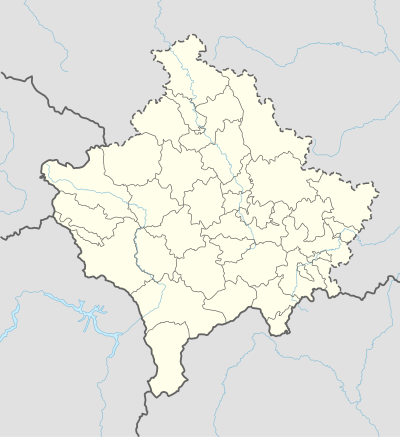Banja, Skenderaj
| Banja Бања Бања, Baja | |
|---|---|
| Settlement | |
 Banja | |
| Coordinates: 42°48′51″N 20°40′21″E / 42.81417°N 20.67250°ECoordinates: 42°48′51″N 20°40′21″E / 42.81417°N 20.67250°E | |
| Country | Kosovo[lower-alpha 1] |
| District | Kosovska Mitrovica |
| Municipality | Skenderaj |
| Elevation | 2,497 ft (761 m) |
| Population (1991) | |
| • Total | 274 |
| Time zone | UTC+1 (CET) |
| • Summer (DST) | UTC+2 (CEST) |
| Area code(s) | +381 290 |
| Car plates | 02 |
Banja (Serbian Cyrillic: Бања, Albanian: Bajë) or Banja Rudnička (Бања Рудничка) is a settlement in the Skenderaj municipality in Kosovo. The rural settlement lies on a cadastral area with the same name, of 1033 hectares. The village has a Serbian majority; in the 1991 census, it had 274 inhabitants.
Geography
Banja is located circa 2 km from Rudnik, on the Peć–Kosovska Mitrovica road.[1]
History
Banje or Banja Rudnička is an Old Serbian settlement.[1] It is mentioned for the first time in a charter of Serbian King Stefan Uroš I (r. 1243–1276), dating to the mid-13th century, granted (metochion) to the Gračanica monastery.[1] It was then granted by King Stefan Milutin (r. 1282–1321) to the Banjska Monastery.[1] The village church, dedicated to St. Nicholas, was founded by nobleman Rodop who served Serbian Despot Đurađ Branković (r. 1427–1456), and was buried here in 1436.[2] Two bells found in its ruins are preserved in the Patriarchal Monastery of Peć and National Museum in Belgrade.[2] Between 1936–41 the church was renovated, but destroyed during World War II[2] by Albanian fascists.[3][4][5] In 1971 the church was reconstructed.[2] The church was used as a model for an Orthodox church in Norway.[6]
On the night of May 21, 1998, a large number of Albanian Kosovo Liberation Army members of Drenica attacked the villages of Banja and Suvo Grlo (which are inhabited by Serbs) and a military station in Rudnik, above Skenderaj. Serbs and Serbian police answered the fire, no deaths or injuries were reported by them.[7]
| Ethnic group | 1948 | 1953 | 1961 | 1971 | 1981[8] | 1991 |
|---|---|---|---|---|---|---|
| Serbs | 338 | |||||
| Albanians | 32 | |||||
| Total[9] | 552 | 595 | 636 | 513 | 371 | 274 |
Annotations
- ↑ Kosovo is the subject of a territorial dispute between the Republic of Kosovo and the Republic of Serbia. The Republic of Kosovo unilaterally declared independence on 17 February 2008, but Serbia continues to claim it as part of its own sovereign territory. The two governments began to normalise relations in 2013, as part of the Brussels Agreement. Kosovo has received formal recognition as an independent state from 113 out of 193 United Nations member states.
References
- 1 2 3 4 Kalezić 2002, p. 131.
- 1 2 3 4 Spomenici.
- ↑ "Kosovo i Metohija, sećanje (IV) – Zoran Bogavac: Nečujna zvona; Dobrica Erić: Svi moji preci". NSPM.
- ↑ "HRIŠĆANSKO NASLEĐE KOSMETA (1)". Glas Srspke.
- ↑ "Православне светиње на Косову и Метохији". Kosmet.
- ↑ "Hellige Trifon skita". Ortodoks.
- ↑ "Dnevnik od 19. do 24. maja". Ilustrovana Politika. 30 May 1998. Archived from the original on 3 January 2009.
- ↑ 1981 Census, Kosovo (Preliminary)
- ↑ Kosovo censuses 1948-1991
Sources
- Kalezić, Dimitrije M. (2002). A - Z. Savremena administracija. p. 131.
- Maletić, Mihailo (1937). Kosovo nekad i danas. p. 402.
- Ristanović, Slobodan (2005). Kroz Srbiju i Crnu Goru. КСЕ-НА. p. 690.
- Влада Републике Србије за Косово и Метохију. "Угрожена културна добра на Косову и Метохији" (PDF).
- "Црква Св. Николе". Spomenici kulture.
- "Čudesno selo Banje: U srcu Drenice, Srbija u srcu". KoSSev.
- "САДА НАМ ЈЕ НАЈТЕЖЕ!". Srpska.